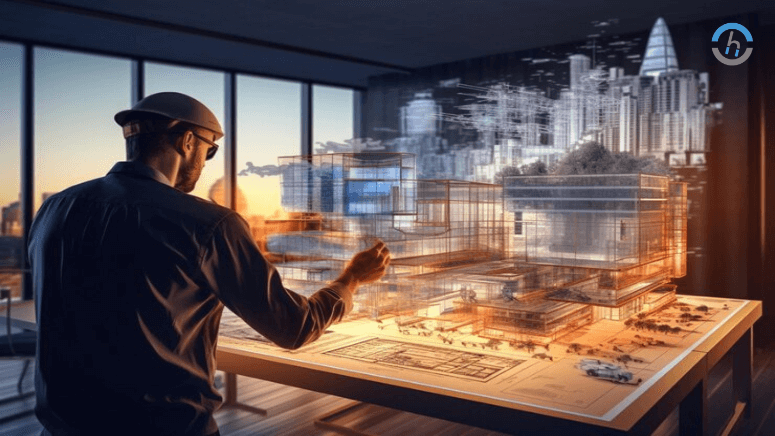Architecture as a sector never stops evolving, and technology permanently imprints a new trend. The Virtual Design and Construction is undoubtedly the most prominent application of virtual design technology, redefining the architecture process mainly because it fastens and refines the work of architects.
This one, as it were, accurately presents the VDC and its importance in modern architecture’s unfolding prospects, a shortcoming that VDC faces, and the bright future it promises.
Overview
In the last 20 years, one can see that the architectural and construction industries have undergone a digital transformation, which will impact entering a new era and possibilities.
Virtual Design and Construction (VDC)—a collective terminology of such practices and tools that brings the design and construction process together and converts it into an integrated digital stream- has been the focus of this change.
VDC reflects the unity of all three factors: innovative design, effectiveness, and practicality in the digital era and gives a new meaning to an architect’s toolset.
Defining VDC in the Age of Digitized Design
VDC combines digital design, virtual simulation, and construction technology, resulting in a thorough project delivery assessment. Coordination between design and construction phases without any constant breaks effectively eliminates mistakes, streamlines the procedure, and increases the project’s efficiency in general.
The Indispensability of VDC
VDC adds immense value in terms of its high standard of adaptability in many different categories and levels of projects. This is crucial for architects, engineers, and builders who aspire to reach the peak of their field.
Its application can overcome design obstacles and help achieve optimal results unique to any given project while also meeting the customer’s expectations.
What is Virtual Design and Construction Technology?
Right at the core of Virtual Design & Construction, it is a leading-edge method that reorganizes management flows in the construction industry. It’s all about creating a virtual representation of the project through a digital twin—a complex digital design of the building construction process.
Using this digital twin, not only the structure is demonstrated but also its operation, as well as interactions with others, are projected, and hence the prior experience of its behavior is provided before the construction.
As the design and construction teams bring their contribution, this digital equipping platform mirrored today gradually transforms after each step of the process and provides the environment for easy updates and optimization. Thus, VDC usages are an effective tool to validate the project’s objective properly, so the building process can be executed successfully with much less human error.
A Detailed Blueprint in Pixels
The software and mobile applications behind VDC are 3D modeling software, cloud computing, and big data analytics. Taken together, this set of instruments contributes to the fulfillment of the architects’ and builders’ outstanding ability to design as well as improve every aspect of a building project’s plan and process.
What is the Difference Between VDC and BIM?
Virtual Design and Construction (VDC) is a concept that involves Building Information Modeling, but the two terms are not interchangeable.
BIM is geared towards the production and administration of digital models representing features of a constructed space as well as the functions it entails. At the same time, VDC adds a stage of the virtual environment creation and managing it throughout all life cycle stages.
VDC as a Continuation of BIM
The virtual world of ecological engineering is either the electronic action following the onset of building information modeling. Additionally, it discusses the design phase but focuses on the following parts – the construction and the operational aspects of the building throughout its life cycle.
Using a concrete simulator and advanced project management not only helps the BIM performance but also provides an integrated and system-wide focus for the entire project.
Benefits of Virtual Design and Construction
The advantages of VDC for virtual design and construction companies are varied. The technology incorporates efficiency, precision, and collaborative potential in the process. Moreover, it leads to cost and time savings and introduces new ways of working through digital collaboration and innovation.
Enhanced Collaboration Among Stakeholders
VDC facilitates multidisciplinary real-time collaboration between design and construction stakeholders and end-users. VDC efficiencies comprise the breaking down of traditional silos that create an ambience where insights are shared, gaps foreseen, and ideas introduced without a hitch.
Improved Visualization and Communication
The visuality of VDC models makes the communication of design intent easier. Stakeholders will be able to navigate through 3D space and learn about the design, leading to a better decision-making process, and the building will surpass expectations.
Cost and Time Efficiency
By comprehensive planning and scheduling, VDC helps detect material and labour conflicts, performs precise material estimation, and optimizes the construction processes. This detailed approach leads to fewer project delays and cost overruns, which is the fundamental economic factor.
Better Decision-Making Through Virtual Simulations
The fact that VDC can run complex simulations, for example, in energy performance or logistics planning, gives the decision-makers data-based insights. This enables the evaluation of various design alternatives in order to make sure that the actual design integrates with the project objective and sustainability requirements.
Challenges and Considerations in Implementing VDC
Although VDC is beautiful in its outcomes, the challenges that it comes with cannot be ignored. There could be technical, organizational, and infrastructure concerns on the way for the builders and specialists who strive for VDC high performance.
Initial Investment and Training Requirements
Implementing VDC is thus the initial expenditure of software, hardware, and training. VDC-skilled talents who are capable of operating VDC tools are crucial but may be challenging to secure, necessitating companies to embark on in-house talent development.
Data Security and Privacy Concerns
The dependence on digital data can undermine the data security and privacy of projects. The protection of secret project information is vital, and it entails significant data governance and cybersecurity measures.
Integration with Existing Project Management Systems
In order for the VDC to be really effective, the integration with already existing project management systems is a must. Enabling interoperability may be complex, with the need for some strategic planning and the willingness to rework traditional workflows.
Ensuring Accuracy and Quality of Virtual Models
The performance of VDC relies heavily on the precision and credibility of its virtual models. Verifying that the digital depictions accurately represent the accurate scale and realistic settings is an ongoing task which needs tight monitoring and rigorous quality control.
Future Trends and Innovations in VDC
The history of VDC is one in which we constantly push the boundaries of possibilities with each new technology coming into the picture to refine and enlarge the scope of our work. The VDC’s future provides opportunities for continuing the production of more sophisticated, effective and environmentally friendly building methods.
Emerging Technologies Shaping the Future of VDC
Among others, AR and VR might be the next frontiers that will change the VDC industry by offering experiential and interactive environments. UAVs and LiDAR are improving site surveys and data gathering, while machine learning and AI may be implemented for a better, AI-driven, self-healing virtual model.
Potential Advancements and Their Impact on the Industry
The generation of 5D BIM — that is, cost management and schedule planning tailored along with 3D, 4D, and 5D models – will add up to a full-fledged project in future. Additive manufacturing (also known as 3D printing) will bring on-site construction out of the traditional way by making accurately produced building parts straight from the digital model.
Conclusion
The rise of VDC has built a fresh footing for modern architecture, one that is digital, alive, and deeply participative. It is being echoed throughout the industry as it helps to make the whole process more efficient, precise, and enduring with the use of virtual design and construction services.
The call to embrace VDC is not just an operational need but also a creative possibility – one that assures projects with unparalleled vision and worth within the domain of architecture and construction.
Outsourcing to a great BIM/VDC vendor is an alternative where you can receive support till the final VDC phase as well as the design stage from the get-go. Essentially, the BIM associate coordinates with all BIM team members to take care of your modeling and coordination needs, thus freeing your mind from the clients.
The vision of Chudasama Outsourcing is to ensure that our clients have confidence and value through quality, quick actions, and consultation.




